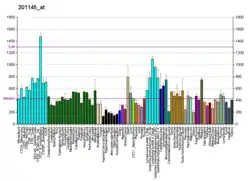HAX1
HCLS1-associated protein X-1 is a protein that in humans is encoded by the HAX1 gene.[5][6][7]
The protein encoded by this gene is known to associate with HS1, a substrate of Src family tyrosine kinases. It also interacts with the product of PKD2 gene, mutations in which are associated with autosomal-dominant polycystic kidney disease, and with F-actin-binding protein, cortactin. It was earlier thought that this gene product is mainly localized in the mitochondria, however, recent studies indicate it to be localized in the cell body. Two transcript variants encoding different isoforms have been found for this gene.[7]
In 2015, localization of the protein to P-bodies was demonstrated.[8]
Severe congenital neutropenia
Homozygous mutations in HAX1 are associated with autosomal recessive severe congenital neutropenia.[9]
Interactions
HAX1 has been shown to interact with IL1A.[10] The protein has also been shown to interact with the 3' untranslated regions of vimentin and DNA polymerase B transcripts.[8] The protein has been shown to interact with the mitochondrial protein disaggregase Skd3 and Skd3 has been shown to be essential for HAX1 solubility within mitochondria.[11]
References
- GRCh38: Ensembl release 89: ENSG00000143575 - Ensembl, May 2017
- GRCm38: Ensembl release 89: ENSMUSG00000027944 - Ensembl, May 2017
- "Human PubMed Reference:". National Center for Biotechnology Information, U.S. National Library of Medicine.
- "Mouse PubMed Reference:". National Center for Biotechnology Information, U.S. National Library of Medicine.
- Suzuki Y, Demoliere C, Kitamura D, Takeshita H, Deuschle U, Watanabe T (Apr 1997). "HAX-1, a novel intracellular protein, localized on mitochondria, directly associates with HS1, a substrate of Src family tyrosine kinases". J Immunol. 158 (6): 2736–44. PMID 9058808.
- Gallagher AR, Cedzich A, Gretz N, Somlo S, Witzgall R (May 2000). "The polycystic kidney disease protein PKD2 interacts with Hax-1, a protein associated with the actin cytoskeleton". Proc Natl Acad Sci U S A. 97 (8): 4017–22. Bibcode:2000PNAS...97.4017G. doi:10.1073/pnas.97.8.4017. PMC 18134. PMID 10760273.
- "Entrez Gene: HAX1 HCLS1 associated protein X-1".
- Zayat V, Balcerak A, Korczynski J, Trebinska A, Wysocki J, Sarnowska E, Chmielarczyk M, Macech E, Konopiński R, Dziembowska M, Grzybowska EA (1 January 2015). "HAX-1: A Novel P-Body Protein". DNA and Cell Biology. 34 (1): 43–54. doi:10.1089/dna.2014.2657. PMC 4281894. PMID 25289648.
- Klein C, Grudzien M, Appaswamy G, et al. (January 2007). "HAX1 deficiency causes autosomal recessive severe congenital neutropenia (Kostmann disease)". Nat. Genet. 39 (1): 86–92. doi:10.1038/ng1940. PMID 17187068. S2CID 22757727.
- Yin, H; Morioka H; Towle C A; Vidal M; Watanabe T; Weissbach L (Aug 2001). "Evidence that HAX-1 is an interleukin-1 alpha N-terminal binding protein". Cytokine. 15 (3): 122–37. doi:10.1006/cyto.2001.0891. ISSN 1043-4666. PMID 11554782.
- Cupo, Ryan R; Shorter, James (2020-06-23). "Skd3 (human CLPB) is a potent mitochondrial protein disaggregase that is inactivated by 3-methylglutaconic aciduria-linked mutations". eLife. 9: e55279. doi:10.7554/eLife.55279. ISSN 2050-084X. PMC 7343390. PMID 32573439.
Further reading
- Modem S, Reddy TR (2007). "An anti-apoptotic protein, Hax-1, inhibits the HIV-1 rev function by altering its sub-cellular localization". J. Cell. Physiol. 214 (1): 14–19. doi:10.1002/jcp.21305. PMID 17929250. S2CID 36596625.
- Klein C, Grudzien M, Appaswamy G, et al. (2007). "HAX1 deficiency causes autosomal recessive severe congenital neutropenia (Kostmann disease)". Nat. Genet. 39 (1): 86–92. doi:10.1038/ng1940. PMID 17187068. S2CID 22757727.
- Kawaguchi Y, Nishimagi E, Tochimoto A, et al. (2006). "Intracellular IL-1α-binding proteins contribute to biological functions of endogenous IL-1α in systemic sclerosis fibroblasts". Proc. Natl. Acad. Sci. U.S.A. 103 (39): 14501–06. Bibcode:2006PNAS..10314501K. doi:10.1073/pnas.0603545103. PMC 1599989. PMID 16971486.
- Han Y, Chen YS, Liu Z, et al. (2006). "Overexpression of HAX-1 protects cardiac myocytes from apoptosis through caspase-9 inhibition". Circ. Res. 99 (4): 415–23. doi:10.1161/01.RES.0000237387.05259.a5. PMID 16857965.
- Rual JF, Venkatesan K, Hao T, et al. (2005). "Towards a proteome-scale map of the human protein-protein interaction network". Nature. 437 (7062): 1173–78. Bibcode:2005Natur.437.1173R. doi:10.1038/nature04209. PMID 16189514. S2CID 4427026.
- Gerhard DS, Wagner L, Feingold EA, et al. (2004). "The Status, Quality, and Expansion of the NIH Full-Length cDNA Project: The Mammalian Gene Collection (MGC)". Genome Res. 14 (10B): 2121–27. doi:10.1101/gr.2596504. PMC 528928. PMID 15489334.
- Ortiz DF, Moseley J, Calderon G, et al. (2004). "Identification of HAX-1 as a protein that binds bile salt export protein and regulates its abundance in the apical membrane of Madin-Darby canine kidney cells". J. Biol. Chem. 279 (31): 32761–70. doi:10.1074/jbc.M404337200. PMID 15159385.
- Bouwmeester T, Bauch A, Ruffner H, et al. (2004). "A physical and functional map of the human TNF-alpha/NF-kappa B signal transduction pathway". Nat. Cell Biol. 6 (2): 97–105. doi:10.1038/ncb1086. PMID 14743216. S2CID 11683986.
- Mirmohammadsadegh A, Tartler U, Michel G, et al. (2003). "HAX-1, identified by differential display reverse transcription polymerase chain reaction, is overexpressed in lesional psoriasis". J. Invest. Dermatol. 120 (6): 1045–51. doi:10.1046/j.1523-1747.2003.12247.x. PMID 12787133.
- Strausberg RL, Feingold EA, Grouse LH, et al. (2003). "Generation and initial analysis of more than 15,000 full-length human and mouse cDNA sequences". Proc. Natl. Acad. Sci. U.S.A. 99 (26): 16899–903. Bibcode:2002PNAS...9916899M. doi:10.1073/pnas.242603899. PMC 139241. PMID 12477932.
- Yin H, Morioka H, Towle CA, et al. (2001). "Evidence that HAX-1 is an interleukin-1 alpha N-terminal binding protein". Cytokine. 15 (3): 122–37. doi:10.1006/cyto.2001.0891. PMID 11554782.




